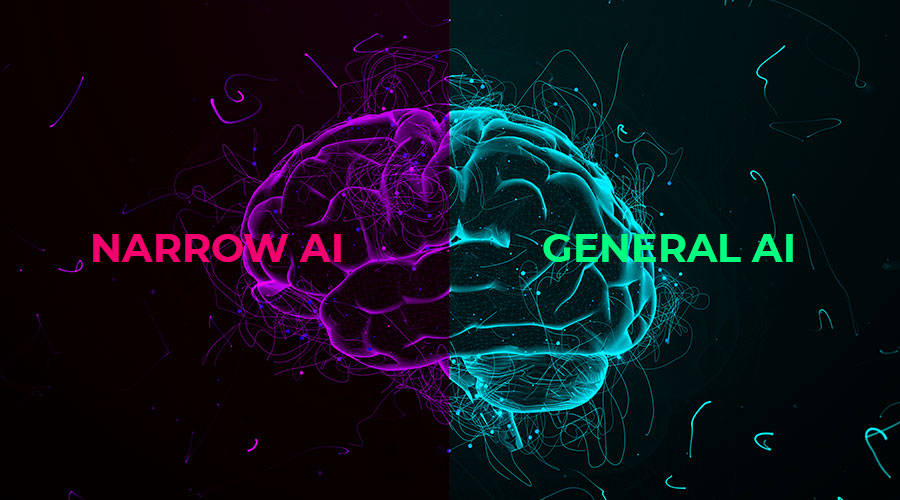Narrow AI
Key Characteristics of Weak AI/Narrow AI
- Task-specific
- No General Intelligence
- Dependence on Data
- Limited Autonomy
- Rule-based or Learning-based
Ten commonly used narrow AI applications:
- Virtual Assistants
Virtual assistants showcasing specialized intelligence tailored for specific tasks. They leverage advanced NLP and voice recognition technologies to recognise and serve to user commands effectively. While they can learn user preferences and interact with a variety of services and devices, their intelligence is confined to their programming and training data. These assistants lack general intelligence, with limited contextual understanding and no ability to generalize knowledge beyond their designated tasks.
- Recommendation Systems
Recommendation systems like those used by Netflix, Amazon, and Spotify are prime examples of Narrow AI, demonstrating specialized intelligence designed to personalize user experiences. Employing sophisticated algorithms and machine learning techniques, these AI systems identify patterns and correlations within the data, enabling them to make highly relevant recommendations. Despite their advanced data processing and predictive capabilities. This specialization allows them to enhance user engagement and satisfaction within their respective platforms.
- Search Engines
Search engines like Google Search exemplify Narrow AI by using specialized intelligence to enhance the user search experience. These systems employ advanced algorithms and machine learning techniques to provide relevant search results, autocomplete queries, and answer questions directly within the search results. By analysing vast amounts of data, including user behaviour, search history, and contextual clues, they can predict user intent and deliver highly relevant information. Despite these sophisticated features, the intelligence of search engines is confined to information retrieval and query processing, without the ability to generalize knowledge beyond their specific domain.
- Social Media
Social media platforms Narrow AI to personalize user experiences through specialized intelligence. These systems analyse user interactions, preferences, and behaviour to suggest friends, display relevant ads, and curate content. Facebook’s AI recommends friends and filters news feed content based on user activity, while Instagram suggests posts and stories tailored to individual preferences. However, their intelligence is limited to specific functions within the social media domain, unable to generalize beyond their designed tasks.
Gmail employs Narrow AI to enhance email management and user efficiency through specialized intelligence. Its AI-driven spam filters use machine learning algorithms. Features like Smart Reply and Smart Compose leverage natural language processing to suggest quick responses and autocompleted sentences, streamlining the process of composing and replying to emails. Despite their advanced functionality, these features are confined to specific tasks within email management and do not possess the general intelligence to operate beyond their programmed scope.
- Customer Service Chat-bots
Customer service chat-bots on many websites exemplify Narrow AI by utilizing specialized intelligence to provide instant support, answer queries, and guide users through common issues. These chat-bots employ NLP and ML algorithms to understand and respond to user inquiries in real-time. They can handle a wide range of predefined questions, provide information, troubleshoot problems. However, their intelligence is limited to specific customer service tasks and scenarios, lacking the broader understanding and adaptability of general AI.
- Navigation and Ride-Sharing
Navigation and ride-sharing services like Google Maps and Uber showcase Narrow AI through specialized intelligence tailored to enhance travel experiences. Google Maps utilizes ML techniques to provide real-time traffic updates, suggest optimal routes, and estimate travel times based on historical and current data. While these AI systems excel in their designated tasks, their intelligence remains confined to navigation and ride-sharing functions, lacking the general intelligence necessary to operate beyond their programmed scope.
- Smart Home Devices
Smart home devices like the Nest Thermostat and Ring Doorbell exemplify Narrow AI by employing specialized intelligence to enhance home automation and security. The Nest Thermostat utilizes ML algorithms to learn user preferences and adjust heating and cooling systems automatically, optimizing energy efficiency and comfort levels. Its ability to analyse usage patterns and adapt settings accordingly demonstrates a level of intelligence specific to climate control tasks. Similarly, the Ring Doorbell employs AI for motion detection, analysing video feeds to identify and alert users of activity at their front door. While these AI systems excel in their designated functions, their intelligence remains tailored to specific smart home tasks and does not extend to broader contexts.
- Image and Speech Recognition
Image and speech recognition applications like Google Photos and voice-to-text services highlight Narrow AI by employing specialized intelligence to process visual and auditory data. Google Photos utilizes advanced image recognition algorithms to automatically categorize and tag photos, enabling users to easily search and organize their photo libraries. This capability demonstrates a level of intelligence specific to image analysis tasks, as the AI can identify objects, people, and scenes within photos. Similarly, voice-to-text services leverage NLP techniques to convert spoken language into written text on smartphones and other devices, facilitating hands-free communication and text input.
- Financial Services
In the realm of financial services, applications such as fraud detection and personal finance management exemplify Narrow AI through specialized intelligence tailored to enhance security and financial well-being. By continuously learning from historical data and detecting deviations from normal behaviour, these AI systems play a crucial role in preventing financial losses and maintaining trust in the banking system. Similarly, personal finance management apps like Mint or YNAB leverage AI to assist users in tracking spending, categorizing expenses, and creating budgets. Through data analysis and pattern recognition, these apps provide insights and recommendations to help users make informed financial decisions.
The widespread integration of Weak AI applications into our daily lives underscores the transformative impact of specialized intelligence. From personalized recommendations to streamlined communication and enhanced security, these AI systems have revolutionized how we interact with technology.
Source
Featured Image

